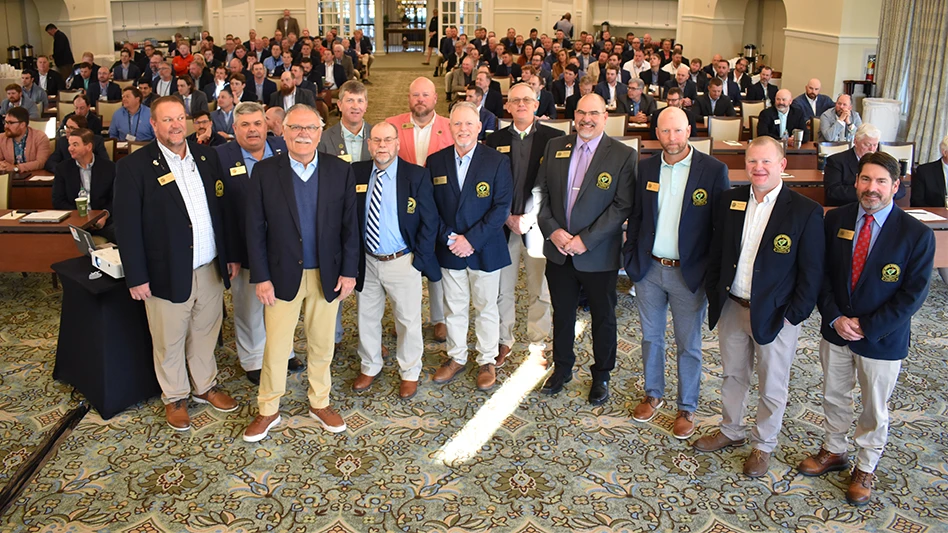 A soil sample reflects sand movement into the soil. All images: Ty McClellan. A soil sample reflects sand movement into the soil. All images: Ty McClellan. |
The only thing constant is change. While superintendents continue aerification as a must in maintaining a healthy course, the last five years has seen quite a bit of change.
Agronomists Ty McClellan, manager of the USGA Green Section’s Education Program, and Adam Moeller of the USGA’s Northeast Region, have both seen growing differences on when courses are being aerated.
Timing. McClellan has found many golf facilities aerate less frequently in the spring and fall than they have in the past. “Much of this movement to aerate less was in response to a challenging economic climate,” he says.
An increase in scheduled outings to make up for lost revenues, declining membership and fewer rounds played all contribute to the economic shortfall. Increased outings combined with reduced maintenance budgets and less staff make it difficult to maintain recommended, aggressive aeration in the spring and fall.
“When aeration is performed it seems the golfing calendar trumps sound agronomic principles, meaning aeration has been pushed earlier into the spring and later in the fall so as to lessen the impact on play,” McClellan adds. “Unfortunately, when aeration is not performed at the ideal times of year, i.e. when the turf is most actively growing, recovery of aeration holes is slowed from as little as 7 to 10 days to a month or more.”
|
Equipment innovations Improvements in walk-behind aeration equipment have provided numerous benefits to the golf industry, says USGA agronomist Adam Moeller. Easy tine type -- hollow, solid, large, small -- and spacing adjustments, allow for a good pace while creating a clean and deep aeration channel. Likewise, offset tires -- so cores are not run over during the process -- are some of the improvements in modern walk-behind aeration equipment. “Better topdressing equipment has also allowed for more accurate and efficient applications of sand to back-fill the aeration channels without applying too much material, which could comproise turf health and delay the process,” Moeller says. Improved core harvesters, sweepers and counter-rotational brushes to incorporate topdressing to fill the aeration channels are other items that have improved the core aeration process. “New ideas such as using pull-behind and/or back-pack blowers to help fill aeration channels have also become popular among superintendents, improving the core aeration process,” Moeller says. “The availability of bagged sand and/or kiln-dried sand has also helped improve the success and speed of backfilling core aeration channels because the dry sand works into the aeration channels and turf canopy much easier than moist sand.” While every situation is different, the USGA’s Ty McClellan says if deep soil modification is necessary — usually on soil-based greens that suffer from poor internal drainage — then the Drill-N-Fill option is very effective. This has become increasingly popular and is usually performed on a contract basis and involves a series of drill bits approximately ¾- to 1-inch in diameter on 6-inch spacings. Holes are created to an 8 to 12-inch depth and backfilled with sand. “Never before has there been such a selection of sophisticated aerators to choose from that will likely meet the specific needs of each golf course,” McClellan says. “Modern aerators are more efficient than older models and create cleaner holes which leads to less golfer disruption and faster turf recovery.”
|
Aerating too early in the spring or too late in the fall, while trying to maintain pure bentgrass greens, is an open invitation for Poa annua encroachment into slow-to-heal aeration holes because it is actively growing, while bentgrass is not.
Moeller has seen the same push of “off-season” aerifying to better accommodate golfers, but understands the dilemma.
“Core aeration when the turf is actively growing and moderate air temperatures occur – late April/early May and late August/early September in the Northeast – is optimal for fast recovery with the least amount of risks,” he says. “These have been the traditional timing for the last few decades, but some are changing primarily to reduce disrupting the golf calendar. Clubs weigh the risks of core aeration in sub-optimal times with the potential benefits of non-disrupted golf in April/May and September and make their decision.
“Core aeration in a sub-optimal time is better than no core aeration at all, though,” he says.
While spring and fall aeration seem to have decreased, minimally disruptive aeration performed in the summer months is on the rise. This is generally performed using small-diameter tines – also referred to as needle or pencil tines that are approximately ¼-inch in diameter – slicing tines or water injection, Moeller says.
“Using these options there is very little, if any, impact on playability of putting surfaces,” he says. “The purpose is to safeguard turf health against summer heat stress by increasing oxygen levels in the rootzone, promoting gas exchange and minimizing root dieback.”
Observations. There are many theories regarding aeration strategies, McClellan says. And while some work, many do not.
The most successful aeration programs for bentgrass or Poa annua greens generally involve a combination of core aeration and deep, solid-tine aeration each spring and fall using tines ½-inch in diameter or larger combined with minimally disruptive aeration techniques (i.e. summer venting) every three weeks or so throughout the growing season, he says. For Bermudagrass greens, the most aggressive aeration practices are performed in the summer during active growth.
“Any aeration program that deviates too much from these standard aeration schedules probably isn’t all that successful long-term,” McClellan says.
Because solid-tine aeration is a very clean process that does not bring soil to the surface, many facilities have gotten away from using hollow tines, or core aeration, he says.
“In very few instances can a golf facility get away from core aeration for more than a few years, but the need to use hollow tines can be reduced if an excellent sand topdressing program is in place,” says McClellan. “With more sand applied more often there is better thatch dilution, less layering in the rootzone and a playing surface that is more traffic-tolerant because sand resists compaction. This means there is less dependency on core aeration, but it does not mean it can be eliminated, just possibly reduced and substituted instead with solid tine aeration more often.”
Moeller, too, has seen increased interest with superintendents following a non-disturbance or zero-disturbance philosophy and thatch control only through dilution with regular topdressing. “This theory supports the idea of thatch dilution and solid tine aeration only; never pulling a core through tradition core aeration,” he says. “While this may work on a limited basis, the concept is largely unsuccessful in the field and increases the chances of thatch buildup.”
In most instances, superintendents adopting the non-disturbance theory benefit from happy golfers when other courses are dealing with core aeration disruption, but at some point they realize thatch is building despite topdressing routinely.
The absence of core aeration concerns Moeller because thatch removal is one of many benefits from core aeration: compaction relief, soil modification, alleviating layering issues and improved rooting are lost or greatly reduced if this process is abandoned.
“Solid-tine aeration in place of core aeration can aid in compaction relief and rooting, but soil modification and addressing any layering issues is very limited unless core aeration is used,” he says. “If people are going to follow the non-disturbance theory, it is essential to frequently test the soil’s physical properties in the upper profile to ensure thatch, porosity and infiltration are not moving in the wrong direction.”
Results. There are few shortcuts when it comes to aeration that won’t ultimately result in deteriorating course conditions down the line, McClellan says. “Whereas a number of golf facilities have remained committed to sound agronomic principles throughout difficult economic times, during my travels and onsite visits to golf courses in recent years, it is obvious that turf problems resulting from soil-related problems are on the rise at a majority of courses visited,” he says.
Less aeration and less sand topdressing leads to higher organic matter accumulation in the root zones and increased soil layering problems. In fairways and approaches, soil compaction problems are becoming increasingly apparent if aeration programs are scaled back or eliminated. Increased organic matter levels and more soil compaction leads to increased soil moisture, reduced soil oxygen and stunted root systems.
“Combine this with record-breaking heat each of the last two summers for much of the United States and it is no surprise that golf facilities experiencing devastating turf loss generally were those that were not on excellent aeration and topdressing programs,” McClellan says.
|
Summer dustings There is a discrepancy in topdressing programs between golf facilities with varying budgets. “Courses with large staffs and modern topdressing equipment can easily administer sufficient quantities of sand each spring and fall in combination with aeration,” says Ty McClellan, manager of the USGA Green Section’s Education Program. “On the rise at higher-budget golf facilities is the application of light quantities of sand every 7 to 14 days throughout the growing season.” Often referred to as “summer dustings,” these small applications are an excellent way to keep pace with ongoing organic matter production, which is needed for new bentgrass and Bermudagrass cultivars that are extremely dense and prolific thatch producers. “Additionally, these frequent, light topdressing applications throughout the growing season actually lead to consistently faster greenspeeds and results in smoother, truer putting surfaces since minor surface imperfections – such as those caused by ballmarks -- are leveled frequently,” McClellan says. Summer dustings of sand have little impact on play and require little to no brushing or dragging to work sand into the turf canopy. Adam Moeller, agronomist with the USGA’s Northeast Region, sees a downside to dustings, which actually stems from improved equipment. “In past decades, superintendents could not apply topdressing too lightly (because the equipment wasn’t that good) where it would have little benefit,” he says. “This has changed with improved topdressing equipment and kiln-dried sand. Unfortunately, this means superintendents can be topdressing every week, but if the application rate is too light, the benefits with thatch dilution and smoothness/firmness are not being realized.” These ultra-light applications may have some minor benefit in surface conditions, but if the application is so light that it is undetectable, it is too light to be really helping improve turf conditions, Moeller adds. This means an application rate of 0.75-1 cubic feet per 1,000 square feet every 7 to 14 days. Those topdressing at <0.5 cubic feet per 1,000 square feet fall in the ultra-light category where the benefits are not likely to be very noticeable. Similar to aeration, topdressing requires resources and time and it, too, has been scaled back in many instances as golf facilities try to navigate through a difficult economic climate, McClellan says. “Sand topdressing is preventative against excessive organic matter accumulation because it dilutes it each time sand is applied,” he says. “When topdressing programs do not keep pace with turfgrass growth, organic matter content increases in the rootzone and more aeration and topdressing will then be required in the future to correct the problem. This is the position in which many golf facilities now find themselves.” |
Rob Thomas is a Cleveland-based freelance writer and frequent GCI contributor.
Get curated news on YOUR industry.
Enter your email to receive our newsletters.
Explore the March 2012 Issue
Check out more from this issue and find your next story to read.
Latest from Golf Course Industry
- Atlanta Athletic Club approves funding for master plan
- PBI-Gordon introduces new field development team
- The Cabot Collection announces move into course management
- Carolinas GCSA raises nearly $300,000 for research
- Advanced Turf Solutions’ Scott Lund expands role
- South Carolina’s Tidewater Golf Club completes renovation project
- SePRO to host webinar on plant growth regulators
- Turfco introduces riding applicator







